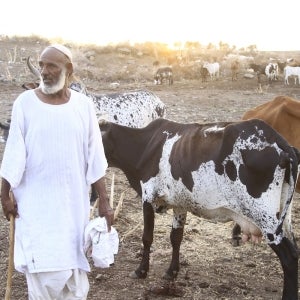[ad_1]
As the global community grapples with the twin crises of poverty alleviation and climate change, the conversation around a “just transition” has become more urgent.
At the core of the challenge lies the fact that climate change does not impact everyone equally. For vulnerable communities, its effects are more severe, often compounding their existing challenges. Actions need to be taken so that these communities are not left behind. This means ensuring they have the support needed to adapt to climate change, access green technologies, and ultimately increase their resilience. But this can’t happen by focusing on climate risks alone; many other risks—such as pandemics, food insecurity, social exclusion, and even disruption from cyber threats—are also on the rise. “Everyday” risks such as the death of the main breadwinner or a health emergency in the family can be catastrophic as well. Each of these can destabilize a low-income household, making it harder for them to recover and build a secure future – underlying the vital role insurance has to play in securing the financial health of those most vulnerable to escalating risks.
Building resilience to all risks, not just climate
This changing risk landscape requires new resilience strategies that consider the interconnectedness of risk. We know the direct risks from climate impacts – for example, flooding and inundation, storm damage, heat stress, and drought. However, one of the biggest dangers of climate change is that it exacerbates other risks. For example, increased heatwaves and natural disasters can lead to higher mortality rates, a rise in disease, and disrupted food production. Again, these risks are particularly pronounced for low-income households, for whom achieving and maintaining financial health – that is, their ability to manage financial obligations and have confidence in their financial future – is already a challenge. Climate change magnifies their existing vulnerabilities and makes it even more difficult to build resilience.
This changing risk landscape requires new resilience strategies that consider the interconnectedness of risk.
To build a truly sustainable world where resilience and prosperity are possible for everyone, we need an inclusive approach that considers all risks, not just climate risk. The global protection gap – which Swiss RE estimates at 1.8 trillion USD – spans health, mortality, crop loss, and natural catastrophes. Without deliberate and targeted action, this gap will continue to widen, leaving the most vulnerable even less capable of withstanding the impacts of climate change and other risks, and making it even more challenging for them to build resilience.
The insurance industry can play a pivotal role here by expanding beyond traditional models for insurance and developing innovative solutions that make the world more sustainable, just, and fair.
The transformative potential of insurance
The insurance industry has an opportunity to drive change. By developing innovative, inclusive insurance models, insurers can make resilience attainable, especially for those who face daily risks with limited resources.
Programs like CGAP partner SEWA’s Extreme Heat microinsurance product, made available to 50,000 women laborers in India to protect them from heatwaves that are dangerous for their health, demonstrates what’s possible when health and climate risk management converge.
Similarly, AXA EssentiALL delivers accessible insurance solutions to reduce everyday risks for communities in climate-vulnerable areas. This allows low-income households to have greater access to quality healthcare services or personal accident cover, for example, which gives the insured party the income or resources to limit the impact of business interruption should they need to take time off work.
Initiatives like these empower low-income communities, equipping them with tools to recover from crises and build their financial health over time.
CGAP and AXA are committed to working together to advance insurance solutions that directly address protection gaps. Both organizations emphasized during a recent AXA EssentiALL event for UNGA and New York Climate Week, entitled “Resilient Futures: Bridging the Protection Gap for Global Financial Health”, the importance of a fair and just transition, and the role insurance can play in carrying out that transition through products that mitigate existing vulnerabilities and protect against emerging risks.
CGAP and AXA are committed to working together to advance insurance solutions that directly address protection gaps.
But building better solutions is just one way that insurers can foster true resilience. Insurers can also leverage their risk assessment capacities and deploy their capital for greater inclusion.
Insurers need to do more… on all fronts
In order to build true resilience, the insurance industry needs to do more and to do better. It is not enough to simply provide a payout to support communities to recover when shocks hit. Insurers must step up to the immense challenge of enhancing their reach and developing innovative models that extend protection to the last mile for a wide range of risks. Insurers have the tools to do this by:
- Developing inclusive solutions – Insurers need to broaden their offerings to cover the full spectrum of risks faced by low-income households, from health and livelihood disruptions to climate-related shocks. SEWA’s extreme heath product and AXA’s Essential range of products are examples of this.
- Leveraging risk assessment capacities – In many jurisdictions, the insurance sector’s expertise in risk assessment and management has already been driving risk-informed, proactive measures, like improved flood defenses or safer building standards. But this risk management expertise can be leveraged further. For example, the Global Risk Modelling Alliance has been set up to support governments with open-source data leveraging the insurance industry’s risk analytics capabilities to help nations better understand their exposure to climate and disaster risk. We need to see more of these types of collaborations. It would also be relevant for insurers to integrate household vulnerability data into their risk analyses so that programs can directly build resilience for the most vulnerable.
- Deploying capital for greater inclusion – With over 40 trillion USD in assets – roughly one-third of all assets under management globally – insurers wield significant financial power. This is 10 times more than what the UNDP estimates is needed to close the financing gap of the SDGs. The launch of blended finance structures, such as the recent IDF Infrastructure Development Blueprint, showcases the influential power that insurance companies can have as some of the largest institutional investors in supporting the just transition agenda. We need more private capital to flow into many critical areas, including climate, if we want to build a truly sustainable and inclusive world. This capital can be strategically directed towards investments that support underserved populations in health, education, and infrastructure, as well as climate adaptation. This capital can be strategically directed toward investments that support underserved populations in health, education, and infrastructure as well as climate adaptation. This is a role that insurers can play at scale.
The urgency to build resilience against climate change is undeniable. In addition, we cannot afford to overlook other risks that also threaten the livelihoods and lives of the most vulnerable. The insurance industry has a unique opportunity – and an obligation – to build greater resilience for all. By harnessing their risk management expertise, capital, and innovation, insurers can be agents of a more inclusive, fair, and resilient world.
[ad_2]
Source link



